True Blue was a thrilling course to play, which was no surprise given Mike Strantz designed it. It may have lacked some of the “what the heck”, head-scratching, jaw-dropping oomph of its sibling Tobacco Road, but I am not an unbiased observer and I also only played True Blue once as opposed to 4 times around Tobacco Road.
True Blue joins a very small group of courses in Myrtle Beach that I have played that is distinctly not what one of my playing partners correctly called ‘cookie cutter’. This is an original course with a varied group of interesting, challenging and exhilarating holes.
Everything is on a large scale here—again, no surprise to anyone who has played Tobacco Road. Playing corridors are quite wide, and the golfer who misses fairways has no one to blame but himself. Strantz provides ample room to roam, letting the golfer decide for himself how he wants to get from here to there, depending upon his skill, the wind or his nerve. There is almost always a decision to be made, or a choice. Do I want to attack the fairway bunker and shorten my approach, or steer clear and settle for the (sometimes absurdly) wide fairway and leave myself further away and with a poorer angle? Can I carry the hill on the right—and is there any advantage for doing so? With the wild contours of the green, where do I wish to attack from (as it was my first round there, I was ignorant of many of these choices).
However, the penalty for a poor decision or a wayward shot can be quite severe. The greens are all very large and boldly contoured, and coupled with impressive bunkering/hazards. Short-sided approaches left incredibly difficult recoveries because of the depth of many of the hazards, the native grasses occasionally in the hazards, the bold undulations of the greens and the greens perched above on hills and knolls. It was not unusual for some greens to be 4-8’ above their surrounds.
The Wardian stats:
7062 74.3/145
6805 72.8/141
6375 70.1/127
6800 yards strikes me normally as a fairly long course, but True Blue did not play long. Some of that yardage was used up in three par 5s that were around 600 yards long each, and there were only 3 par 4s over 415 yards.
(Note: all yardages are from the 6805 tees that we played)
(Note 2: half the fairways had been aerified)
The first hole is a 600 yard par 5 with an ample fairway (a common theme). There is realistically no chance to reach in two, so the goal is to avoid the waste areas and leave yourself a wedge in. This is one narrow green, raised above it surroundings—a brook, deep bunkers, wild shrubs. Should be a comfortable start, as long as you stay in the fairway and hit the skinny green.
Number two is a terrific little par 4 of 335 yards. You can’t see much from the tee, or at least anything good. The marker tells you the fairway ends 240 yards away. Too far left, you miss the fairway, too far right, you find waste area and oak trees blocking the line to the green. The 50 yard long green (no typo) is quite narrow in the front and widens in the back as it wraps around a waste bunker.
This is the approach shot:
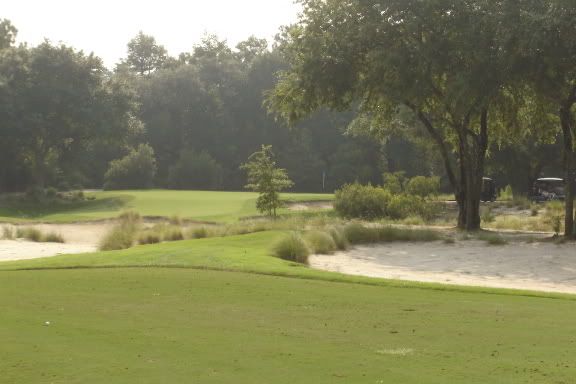
And this is what happens if you come up a little short (sorry Rob!):

Number three is a 160 yard par 3 that is shaped like Florida (credit to Rob for that observation). An island green, this hole made me realize that one of the big differences between here and Tobacco Road was the use of water. Much more here.
Typical Strantz par 3 in that the green is segmented into separate little mini-greens.
The very front of the green has a severe downslope, and anything hitting it likely will not stay on the green.
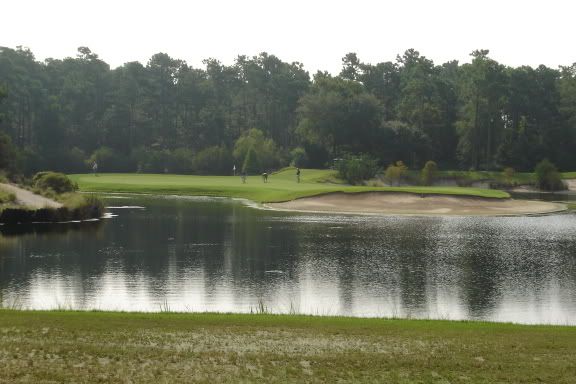
Number 4 is another of Strantz’ teasing, doglegging par 5s. This one is 523 and wraps around a lake. Hug the lake, and you can hit it in 2. Bail out, and you will likely be too far to have a go (though some players are too dense to tack around the lake at that point. Sigh).
Number 6 is 393, and the drive is over a wetland. This one felt out of character with the rest, and was the least memorable. For some reason, there are two greens here.
The 164 yard 7th is another 50 yard long green, sloping severely right to left. Right is a waste area, left leaves you well below the green. There is a back tier that would be very dicey to hit to.
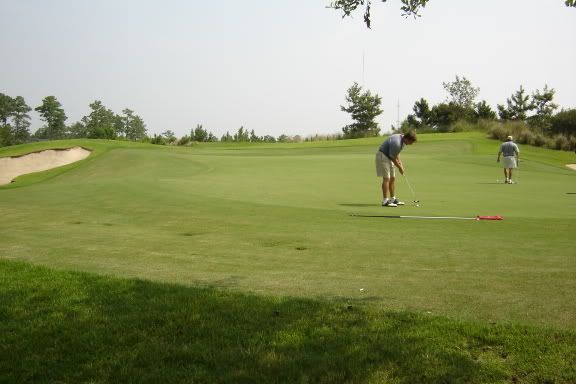
The 8th is a short (363 yards) par 4 that plays well. It doglegs sharply to the right, though at least half the hole is blind from the tee. A small boulder sits atop the hill on the inside corner and is a target off the tee. Longer hitters can choose exactly how much of the hill they wish to carry, and the shorter or more timid can bail left into a fairly undulating fairway. The green is large, and has rolls throughout. Approaches hit to the front or left, perhaps up to 4-5’ feet onto the green, stand a very good chance of spinning back down the hill, ending up 6 or 8 feet below the green either in fairway height grass, rough, or bunker.
This is from short and a little left of the green:
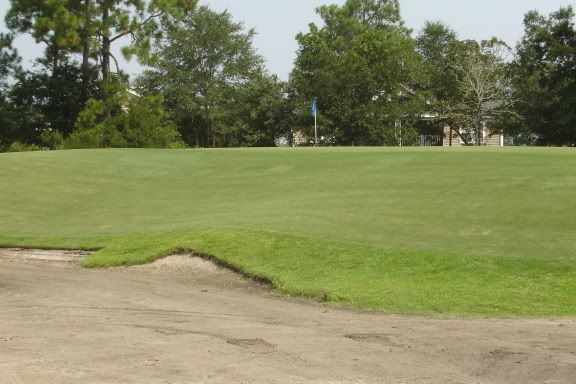
Nine is a reachable par 5 of 532 yards. Though I played the hole fairly well, this hole lacked some oomph for me. One interesting shot: if you are laying up with the second shot, it may be better to hit well right of the green rather than at the green. It feels wrong somehow but the angle between the bunkers and up the green may play much better.
From our tee shots, ~240 yards to go:
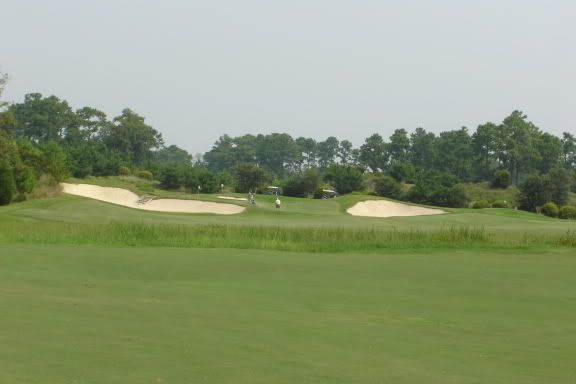
The tenth is a lengthy par 5, just less than 600 yards. It feels Tobacco Road-ish off the tee with the large waster area inside the sharp dogleg, but there is never a sense that this one is reachable.
There are a row of diagonal bunkers to contend with for the second shot. The is much more room left of the bunkers than it appears:
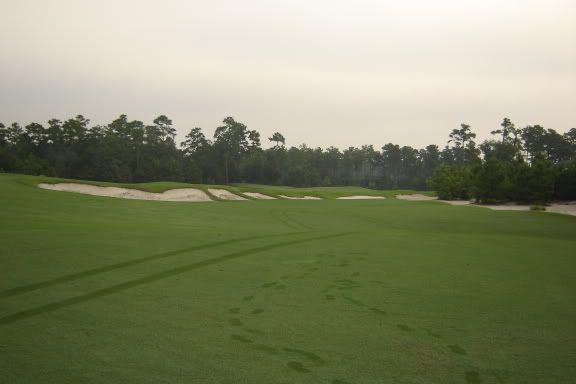
The green sits just over a small ditch, and is much wider than it is long. There are some wild contours that can be used to maneuver the ball, though the course would need to be firmer for that effect to work.
Taken from right of the green:
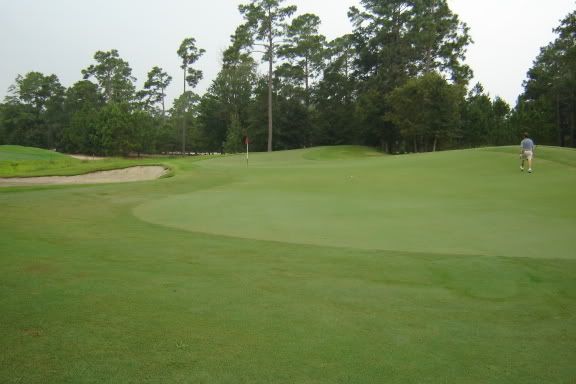
13 is a 400 yard par 4 that plays semi-blind for both the tee shot and the approach. A small hill intrudes from the left off the tee, tending to force the tee shot further right. Unfortunately, there is no real advantage to driving right or left other than ensuring the drive avoids the waste area right.
Imposing bunkers guard the green, and despite appearances, they are actually 25-30 yards short of the green. The green has a punchbowl feel to it, with shots tending to funnel towards the middle. There is a large slope to the right that can be used as a backstop. Hard to get a feel for the approach as much of the green is hidden from view.
The pin is hard to see, but is at the right side of the center bunker:
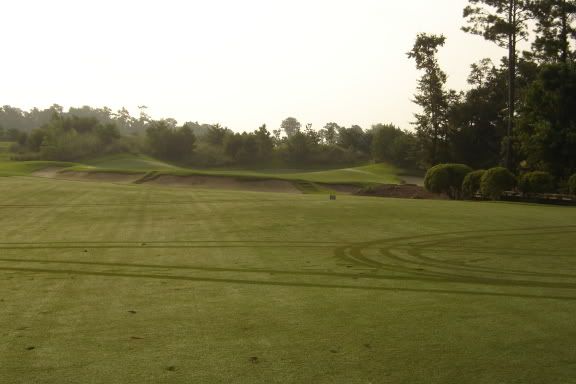
Number 14 is a 154 par 3 with a 40 yard long, hour-glass shaped green that is decidedly segmented into mini-greens. It’s slightly reminiscent of 17 at TR.
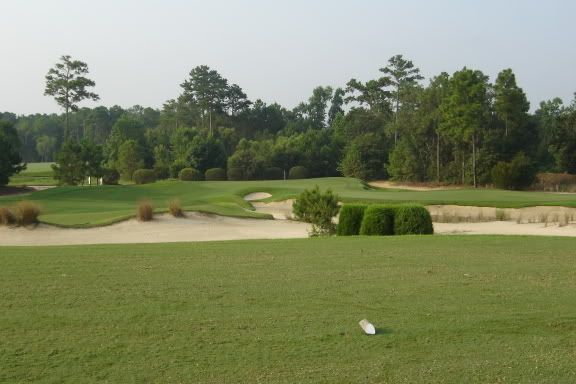
15 is another 600 yard par 5, and the first two shots are there to put you as close as possible, in the fairway, for a high soft approach. There is a lot of fairway here, and not a lot of reason to be over-bold. The green is raised up above its surroundings, and shots just long will roll all the way down, maybe 6 feet below the green surface. This is from right and over the green:
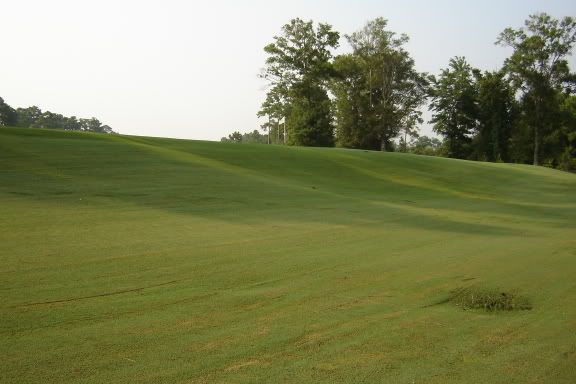
The last three holes all play over and along water.
16 is 200 yards, all carry, with a large bunker flowing into the pond:
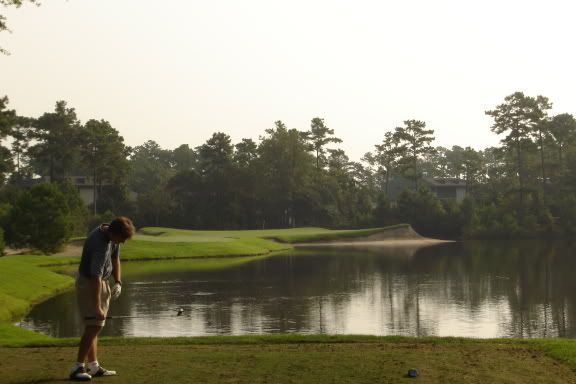
Number 17 is 426 yards, with water down the right side and fronting the green. Oddly, there is no advantage for challenging the water down the right off the tee—if anything, the green orients itself better to an approach from the left-center.

18 is 419 yards, with the tee shot over water and water in play all down the left. Its an intimidating tee shot, and I am sure many balls end up in the trees right. The green has a very large slope right-to-left that can be used to hit away from the water and still run down to the hole.
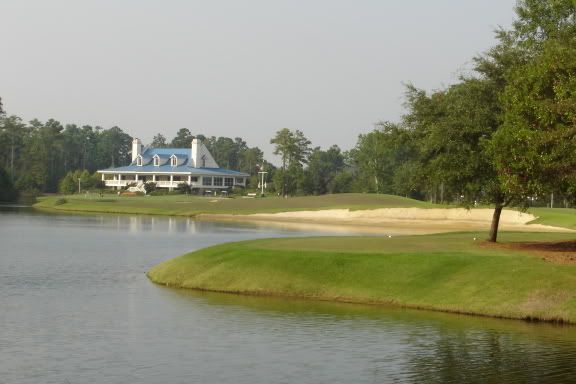
My only major complaint with the course was its conditioning. Its in terrific shape, but it is very soft. Drives often leave a pitch mark and stop after a hop. The greens have terrific, exciting slopes, but they lose much of their appeal and usefulness when balls stop on them. The strategy built into some of the holes disappears if the wild slopes of the greens can be ignored. And the fun of using internal hills and undulations to get near certain hole locations is lost. Much or all of this may be attributable to the time of year—it is August and it is very hot in Myrtle Beach at this time, so it might be necessary to keep things soft just to keep them alive.